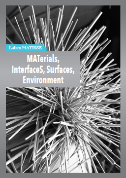Topological metadynamics for poly(a)morphism
Axe T - Méthodologies pour la modélisation des matériaux
Post-doctorat de Silvio Pipolo
Projet de recherche mené du 01/07/2015 au 31/12/2016.
Laboratoires co-porteurs
- Institut de Minéralogie, de Physique des Matériaux et de Cosmochimie (IMPMC)
Porteur de projet : Fabio Pietrucci
Co-encadrant : Guillaume Ferlat, A. Marco Saitta - Laboratoire PHENIX - CNRS
Co-encadrant : Mathieu Salanne
Résumé du projet
The transformations of matter, leading to a reorganization of atomic structures under different forms, are the object of intensive research in physics, chemistry, materials science, and beyond. In this domain, experimental studies go often hand in hand with computer simulations, that allow to visualize the transition mechanisms in atomic detail. Unfortunately, the very important class of disorder-to-order transformations – including ice formation from liquid water – is extremely challenging to simulate. Typically, the nucleation process leading to the growth of a crystal out of a disordered system features extremely long time scales, larger by several orders of magnitude than the computational time scale.
With the present project, a team of researchers from the IMPMC and PHENIX labs of Sorbonne University developed a new computational approach that allowed, for the first time, to simulate several transitions across the phase diagram of water – including the crystallization starting from liquid and amorphous forms – using an accurate interatomic potential (TIP4P/2005). In particular, the new technique is unaffected by large kinetic barriers and thus overcomes the problem of studying nucleation at (or even beyond) the melting point [1].
The same approach allowed to simulate heterogeneous ice nucleation, demonstrating that different surfaces lead to different ice polymorphs, a violation of classical heterogeneous nucleation theory [2]. The new method (implemented in the freely available plugin Plumed) exploits enhanced sampling techniques like metadynamics and umbrella sampling, in combination with a new definition of reaction coordinates. The latter are constructed starting from the adjacency matrix of interatomic connections, encompass all possible permutations of identical atoms, and are able to track in a general way the changes of topology of atomic structures in condensed matter. This approach might be therefore applied to a wide range of different problems, including the prediction of experimental synthetic routes for new materials.
[1] S. Pipolo, M. Salanne, G. Ferlat, S. Klotz, A.M. Saitta, F. Pietrucci, Navigating at will on the water phase diagram, Phys. Rev. Lett. 119, 245701 (2017) https://doi.org/10.1103/PhysRevLett.119.245701
[2] M. Fitzner, G.C. Sosso, F. Pietrucci, S. Pipolo, A. Michaelides, Pre-critical fluctuations and what they disclose about heterogeneous crystal nucleation, Nat. Commun. 8, 2257 (2017) http://dx.doi.org/10.1038/s41467-017-02300-x

Publication
- Martin Fitzner, Gabriele Sosso, Fabio Pietrucci, Silvio Pipolo, Angelos Michaelides.
Pre-critical fluctuations and what they disclose about heterogeneous crystal nucleation
Nature Communications, Nature Publishing Group, 2017, 8, pp.2257.
DOI : 10.1038/s41467-017-02300-x
Ref HAL : hal-01678826v1 - S. Pipolo, M. Salanne, G. Ferlat, S. Klotz, A. m. Saitta, F. Pietrucci
Navigating at Will on the Water Phase Diagram
Physical Review Letters, American Physical Society, 2017, 119 (24)
DOI : 10.1103/physrevlett.119.245701
Ref HAL : hal-01921261
Egalement dans la rubrique
- Combinaison auto-cohérente de la théorie de la fonctionnelle de la densité(DFT) et du Monte Carlo quantique (QMC) pour l’étude des matériaux
- Modélisation des effets quantiques nucléaires : approches théorique pour la dynamique quantique des noyaux
- Transport des métaux par les fluides hydrothermaux riches en soufrepage
MATISSE en chiffres
- 4 disciplines : Chimie, Physique, Sciences de la Terre, Patrimoine
- 400 permanents
Contact
Direction
Florence Babonneau
Administration
Communication
Emmanuel Sautjeau



